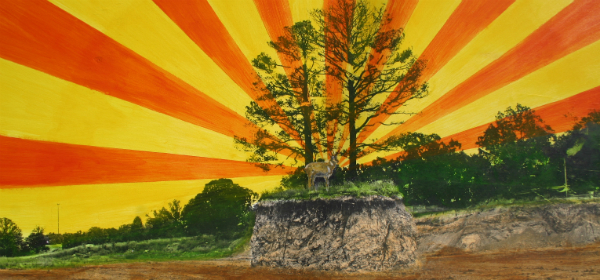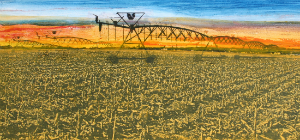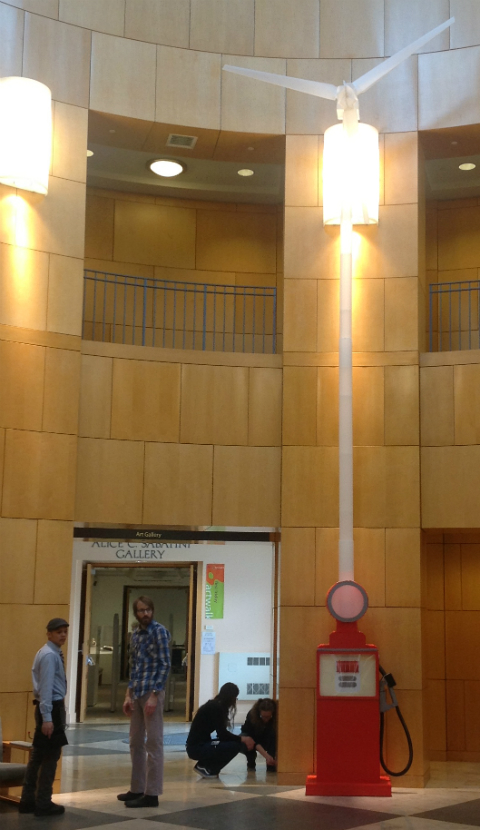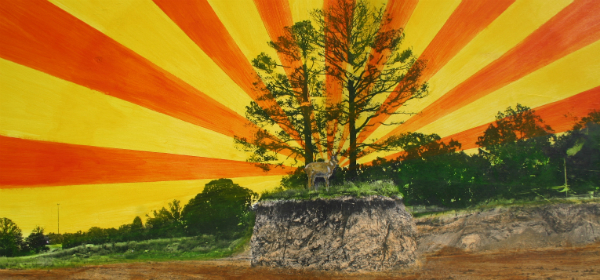
An antelope on what's left of its environment symbolizes human impact on habitat. What do we do to our own habitat?

Irrigation systems inspired Marable to think about farming and water use. This piece was his first test of the photo-transfer process in many of the works.
What does that mean? Here are some questions people have asked us about this work, and my interpretations.
What’s the meaning of the different dinosaurs and how do they relate to the machines? The dinosaurs represent the past. 150-65 million years ago, the Midwest was covered by an inland shallow sea. The mosasaur (Juniper’s irrigation machine in front, and Justin’s piece Black Magic from Below) was one of the creatures who lived in that sea. Both artists read Oceans of Kansas as part of their research. The author talks about the different species that are found in Kansas fossils, especially in the salt and limestone deposits in central Kansas and western Kansas. The pterodactyl was a flying lizard that flew over those waters. The plants and animals that lived then became the oil deposits we pump now. The past is connected to the present. The artists represent the present through the machinery - the oil derrick, water irrigation system, solar panels.
Why are the bison and calf part oil derrick? In my humble opinion, Juniper is using the bison, which was once nearly extinct, as a metaphor for the dwindling oil supplies we use for energy. The movement of the derrick is combined with the movement of the bison’s head, up and down, to graze. We consume the oil, the bison consumes grass. Ultimately, both are threatened by things changing. For the bison, it was loss of habitat and overhunting. The oil deposits, because people use it up, and using it (consuming it) is causing carbon buildup, climate change, and pollution. Neither are sustainable without intervention. People had to work to save the bison, after having nearly hunted them to extinction, exhausting a resource. Now, we’re consuming oil for energy, exhausting that resource.

Using recycled corrugated plastics, Tangpuz mixes technologies. An old-style gas pump mixed with a contemporary windmill presents two alternatives to energy.
How does the title “Consumed” relate to the exhibit? Both Justin and Juniper have talked about conservation, land use, energy use, food production, and the use of space. As we use those resources, we consume them. The definition of “consumed” is to use, to eat, or to use up. The 'consumed' title relates to that use, and people and animals HAVE to consume to survive. How do we do that? Do we use it up, or do we change our behavior so that what we consume, we consume in a sustainable way? Justin uses the elk, bison, antelope, and coyote as species whose environments have been changed by people. We consumed their environment, putting them at risk. The dinosaurs obviously weren’t affected by people, as we hadn’t evolved yet. But their environment was radically changed by the processes of nature. Continental drift pushed the plates of North America up, into the Rocky Mountains, which raised the Midwest up above sea level. The sea drained away, those animals and plants that lived in that environment died our or moved to other waters. Eventually, the world changed enough that the dinosaurs went extinct. (Most of them, anyway.) Then, a new environment developed, which ultimately became the prairies of the Midwest. New animals evolved. New species arrived. Then we got here and changed it again.
The combinations of the periods of history take time out of the equation. What if all of those species, and all of those environments, could exist at the same time? What would a pterodactyl do with 21st century technology? What forms are similar to each other, like the mosasaur skeleton, and the water irrigation machine? As we change the environment, we change the animals that live in it. Hence, the combo bison and oil derrick. What else will we change? Will we make it better, or worse? What other things can we develop that would be better uses of energy, resources and land? How does government policy affect how we use our resources?















